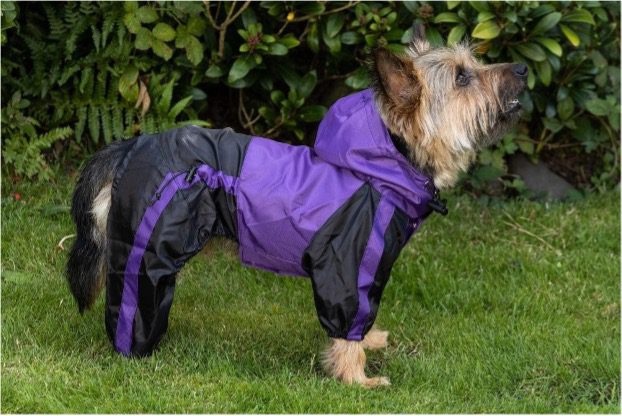It's simple to feel peaceful while the ground is graced with rainfall and a refreshing petrichor fills the air. However, as a dog owner, the rainy season could also provide a challenge—how to keep your furry friend comfy and fashionable while making sure they stay dry and warm on walks.
The reliable dog raincoat with legs enters the picture at this point and completely changes how we shield our four-legged pals from the weather. In this comprehensive guide, we dive into the world of canine fashion and functionality, exploring the key factors to consider when selecting the perfect raincoat for your beloved pup.
We've got you covered on everything from size and materials to style and durability, so you and your canine buddy can enjoy those rainy strolls together without a care in the world. Prepare to learn how to endure the storm with your tail-wagging companion while also enjoying it.
Why Your Dog Needs a Raincoat With Legs?
Some dogs are naturally resistant to water and have thick coats that can repel moisture and keep them warm. However, not all dogs are suited for wet weather. Some dogs have short or thin coats that can easily get soaked and chilled in the rain.
Some dogs have sensitive skin that can get irritated by wetness and mud. Some dogs are simply not fond of getting wet and may refuse to go outside or enjoy their walks in the rain.
A dog raincoat with legs can solve these problems by providing full-body coverage and protection for your dog, for the following reasons.
- Keeps your dog dry and warm. Rain can lower your dog’s body temperature and make them shiver. A wet coat can also trap moisture and bacteria on your dog’s skin, leading to skin irritations. A raincoat with legs can prevent these issues by keeping your dog’s fur dry and insulating their body heat.
- Keeps your dog clean and reduces grooming. Rain can make your dog dirty and muddy, especially if they like to roll or splash in puddles. This can make your house messy and require more frequent baths for your dog. A raincoat with legs can prevent this by covering your dog’s body and preventing dirt and mud from sticking to their fur.
- Protects your dog from injuries and infections. Rain can also expose your dog to harmful substances or objects on the ground, such as chemicals, sharp rocks or glass. These can injure your dog’s paws or legs, or cause infections. A raincoat with legs can protect your dog’s paws and legs from these hazards by providing a barrier between them and the ground.
- Makes your dog more visible. Rain can reduce visibility and make it harder for drivers or pedestrians to see your dog. This can increase the risk of accidents or collisions. A raincoat with legs can make your dog more visible and safe by featuring reflective strips or bright colors that reflect light and catch attention.
How To Measure Your Dog for a Raincoat With Legs
Even if your dog likes being in the rain, it’s still a good idea to measure them for a raincoat in case you need to take them out in heavy rain. This is especially important if you’re wondering why does my dog stay out in the rain. The coat will keep them dry and comfortable even if they insist on being outside. Here are the steps to measure your dog for a raincoat with legs:
- Measure your dog’s back. This is the distance from the base of your dog’s neck (where the collar sits) to the base of their tail (where the tail joins the body). You can use a measuring tape or a piece of string to measure this length along your dog’s spine.
- Measure your dog’s chest girth. This is the circumference of your dog’s chest at its widest point (usually behind the front legs). You can wrap a measuring tape or a piece of string around your dog’s chest and mark where it meets.
- Measure your dog’s neck girth. This is the circumference of your dog’s neck at its narrowest point (usually where the collar sits). You can wrap a measuring tape or a piece of string around your dog’s neck and mark where it meets.
- Measure your dog’s leg length. This is the distance from the top of your dog’s leg (where it joins the body) to the bottom of their paw (where it touches the ground). You can use a measuring tape or a piece of string to measure this length along each leg.
- Compare your measurements with the size chart of the raincoat you want to buy. Different brands may have different size charts, so make sure you check them carefully before ordering. You may also need to consider other factors such as weight, breed or body shape when choosing a size.
How To Choose the Right Material for Your Dog’s Raincoat With Legs
The material of your dog’s raincoat with legs is another important factor to consider when buying one. The material affects how waterproof, breathable, durable, comfortable and easy to clean the raincoat is. Here are some of the common materials used for making dog raincoats with legs:
- Polyester. A synthetic fabric that is lightweight, waterproof, windproof, and resistant to tearing and abrasion. It is also easy to wash and dry. However, polyester is not very breathable, which means it can trap heat and moisture inside the coat and make your dog feel hot or sweaty. Polyester can also cause static electricity or allergies in some dogs.
- Nylon. Another synthetic fabric that is similar to polyester in terms of being lightweight, waterproof, windproof and resistant to tearing. It is also easy to wash and dry. However, nylon is also not very breathable, which means it can trap heat and moisture inside the coat and make your dog feel hot or sweaty. Nylon can also cause static electricity or allergies in some dogs.
- TPU. Thermoplastic polyurethane, a type of plastic that is flexible, waterproof and often used as a coating on other fabrics to make them more waterproof and resistant to wear and tear. TPU is also breathable, which means it allows air and moisture to pass through the coat and keep your dog cool and dry. However, TPU can be stiff or noisy when your dog moves, which may bother some dogs or owners.
- PVC. Polyvinyl chloride is another type of plastic that is waterproof and is often used as a coating on other fabrics to make them more waterproof and resistant to wear and tear. PVC is also cheap and easy to clean. However, PVC is not breathable, which means it traps heat and moisture inside the coat and makes your dog feel hot or sweaty. PVC can also be toxic or harmful to the environment if not disposed of properly.
- Cotton. A natural fabric that is soft, comfortable and can absorb moisture to keep your dog cool and dry. However, cotton is not waterproof, which means it can get wet and heavy in the rain. Cotton can also shrink or fade when washed or exposed to sunlight.
How To Choose the Right Style for Your Dog’s Raincoat With Legs
The style of your dog’s raincoat with legs is another factor to consider when buying one. The style affects how well the raincoat covers your dog’s body, how easy it is to put on and take off, how secure it stays on your dog’s body and how fashionable it looks. Here are some of the common styles of dog raincoats with legs:
- Vest style. A vest style raincoat covers your dog’s back, chest, belly and front. It usually has a zipper or velcro closure on the back or chest and elastic or adjustable straps on the legs. A vest style raincoat is easy to put on and take off, but it may not provide enough coverage for your dog’s rear legs or tail.
- Poncho style. A poncho style raincoat covers your dog’s back, chest, belly and all four legs. It usually has a hood that covers your dog’s head and neck, and a drawstring or velcro closure on the waist. A poncho style raincoat provides full coverage for your dog’s body, but it may be harder to put on and take off or interfere with your dog’s movement or vision.
- Jacket style. A jacket style raincoat covers your dog’s back, chest, belly and all four legs. It usually has a collar that covers your dog’s neck, sleeves that cover your dog’s legs and a zipper or button closure on the chest or belly. A jacket style raincoat provides full coverage for your dog’s body, but it may be harder to put on and take off or fit snugly on your dog’s body.
Benefits of Having a Dog Raincoat With Legs
Having a dog raincoat with legs can have many benefits for you and your dog.
- Keeps your dog dry and warm in rainy. This can prevent your dog from getting colds, skin infections, ear infections or joint pain due to wetness or low temperature.
- Keeps your dog clean and reduces grooming needs. This can prevent your dog from getting dirty or muddy due to rain or puddles. This can also save you time and money on bathing or brushing your dog frequently.
- Protects your dog from injuries and infections in rainy weather. This can prevent your dog from getting hurt or infected by harmful substances or objects on the ground due to rain or mud.
- Makes your dog more visible and safe in rainy weather. This can prevent your dog from getting lost or hit by cars or people due to low visibility due to rain or fog.
- Makes your dog more comfortable and happy. This can prevent your dog from feeling miserable or unhappy due to wetness or coldness due to rain.
- Makes you more comfortable and happy. This can prevent you from feeling stressed or annoyed due to wetness or dirtiness because of rainy weather.
Well, That’s a Wrap
A dog raincoat with legs can be a great accessory for your pup if you enjoy walking them in any weather. By considering factors such as size and fit, material and quality, style and design, you can choose the perfect dog raincoat with legs for your furry friend.
Remember to measure your dog properly before buying a raincoat with legs and look for one that meets their needs and preferences. Your dog will thank you for keeping them dry, warm, and stylish in the rain!



